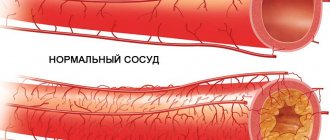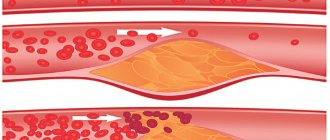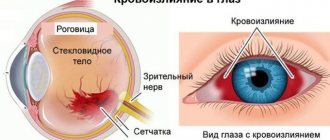Home>Articles>Effects of ethanol on blood vessels
quick menu (hide)
- Alcohol and blood vessels
- Effect on cerebral vessels
- Effect on the central nervous system
- The mechanism of action of alcohol
- Causes of vasoconstriction
- Pathologies caused by alcohol
- Brief effects of alcohol
- Consequences of frequent drinking
After drinking alcohol, a short-term positive effect is observed. Alcohol and blood vessels interact and the person’s condition improves. But it doesn't last long.
Alcohol constricts or dilates blood vessels
In the first few moments, alcohol acts as a vasodilator. There is also an additional burden on the cardiovascular system. The number of heart contractions increases. This leads to an increase in the volume of pumped liquid. This state of affairs can have a negative impact on human health.
In a matter of moments, alcohol enters the bloodstream and stays there for up to seven hours. The pulse quickens, blood circulation and metabolism are impaired.
Additional doses of hormones are released into the blood:
- adrenaline,
- norepinephrine.
This has an adverse effect on the psyche, causing stress and mental disorders.
Strong liquor
It doesn’t matter what kind of alcohol was drunk - strong or weak, the effect of alcohol on blood vessels depends on the following circumstances:
- volume of alcohol consumed (large amounts of alcohol increases blood pressure),
- a person’s age (with age-related weakening of health, the effect of alcohol on the kidneys and liver only increases),
- regularity of libations.
Complete 100% abstinence should be recommended for those who suffer from vegetative-vascular disorders, neuroses, and diseases of the endocrine system.
What happens to the heart when taking high doses of alcohol?
As soon as the heart muscle is exposed to the negative influence of large amounts of alcohol, the following pathological changes are observed:
- the myocardium begins to contract poorly;
- heart rhythm is disturbed (usually towards tachycardia);
- blood oxygen saturation decreases (hence severe shortness of breath);
- The minute volume of blood decreases, due to which the atria and ventricles do not receive important nutrients and oxygen.
Drinking heart patients often develop edema. They suffer from an unpleasant feeling of lack of air. If you ignore all these symptoms, dangerous complications cannot be avoided in the near future.
How does alcohol affect the blood vessels of the brain?
People who regularly abuse alcohol are six times more likely to develop pathologies of the circulatory system of the brain. Such people can expect to experience:
- encephalopathy - a disease accompanied by massive death of cells in the central nervous system,
- ischemic strokes - acute circulatory disorders accompanied by the death of parts of the brain,
- atherosclerotic phenomena - damage to the vascular system due to the accumulation of fat on the wall and the formation of lipid plaques,
- VSD is a disorder, at its root is a decrease in vascular tone.
All diseases proceed according to the worst scenario and lead to mental deviations. A person's health can be restored only after three years .
Single numbers for recording:
What is alcohol?
Alcohol is a depressant, that is, a substance that slows down all processes in the body. Small doses of alcohol give a feeling of relaxation and self-confidence. In large doses, it slows down the reaction and negatively affects, for example, the eye and coordination. Driving while not sober is extremely dangerous. A person in a state of severe intoxication experiences nausea, dizziness, and may lose consciousness, then on top of everything else there is the danger of choking on his own vomit.
The degree of intoxication may depend in part on the strength of the drink, that is, on the concentration of alcohol in it. The strongest drinks are whiskey, vodka, followed by various wines, and finally, BEER. In addition, the size of the drinker matters. In general, larger people are more resistant to the effects of alcohol than smaller people.
Alcohol abuse can lead to obesity, because alcohol contains calories, although it is not nutritious at all, to ulcers, cirrhosis of the liver, as well as to diseases of the brain, kidneys and muscles, including the heart.
The brain of a person who regularly drinks alcohol in large doses constantly struggles with its depressive effects. If such a person stops drinking, his brain, by inertia, continues its compensatory activity, which is why he becomes excited, nervous, fussy, his hands tremble, and this continues until he drinks more. Here is a typical example of alcohol addiction.
Scientific studies and statistics show that people who drink alcohol in light or moderate doses have lower premature mortality than non-drinkers and heavy drinkers. Various theories have been put forward to explain this phenomenon: some believe that alcohol causes the body to produce substances known as high-density lipoproteins, which prevent cholesterol from depositing in the arteries. Others believe that the heart is protected by substances found in certain varieties of red wines that inhibit oxidative processes. The well-known relaxing effect of alcohol also helps with stress.
It would be bad if these facts prompted someone to take a drink for the first time or increase their alcohol consumption. Drinking destroys the brain, liver, digestive tract and stomach. Liver cirrhosis and pancreatic cancer are diseases of drinkers. Obesity and hypertension, as well as heart disease, are the result of heavy drinking.
The level of alcohol concentration in the blood depends on a number of factors.
- If you eat fatty foods, then intoxication will not be as quick.
- The high content of animal and vegetable fats slows down the absorption of alcohol and the digestion of the food itself.
- The fuller the stomach, the longer it will take for alcohol to reach the circulatory system.
- The thicker your body fat, the slower alcohol is digested and absorbed into the blood.
- Body weight: the heavier you are, the lesser the effects of alcohol on you.
- Your reaction to drinking 80 mg of alcohol may be completely different than someone else's. Typically, young people and women are more susceptible to alcohol.
The ability to consume alcohol and the effect it has on different people varies; however, it is believed that a safe dose (from a health point of view) is somewhere around 5 liters of BEER of medium strength or 10 large glasses of wine per week for men and 2/ 3 of this dose for women, provided, of course, that this amount will be lost evenly over the course of a week, and not in 1-2 times. If you can, try not to drink on an empty stomach.
One of the surest ways to avoid a hangover is to not drink on an empty stomach. Some argue that drinking a glass of milk before drinking alcohol slows down its absorption in the body. Following this advice, drink in moderation and dilute alcoholic drinks.
Alcoholism – what is it?
Alcoholism is the regular, compulsive consumption of large amounts of alcohol over a long period of time. It is the most serious form of drug addiction in modern times, affecting between 1 and 5% of the population in most countries. An alcoholic drinks compulsively in response to a psychological or physical dependence on alcohol.
Anyone can become an alcoholic. However, studies have shown that for children of alcoholics, the risk of becoming alcohol dependent is 4-6 times higher than for children of non-alcoholics.
The study of alcohol consumption among young people in Russia is largely based on the experience of similar studies abroad, which in the late 19th and early 20th centuries were widely carried out in Western Europe and North America and were conducted in a variety of directions:
- The prevalence and patterns of alcohol consumption among students were studied.
- The effect of alcohol on children's and adolescents' bodies was studied.
- The relationship between academic performance and alcohol consumption was determined.
- Anti-alcohol education programs were developed and tested.
A significant place among the studies of this period was occupied by works illustrating the prevalence and nature of drinking customs, when children were given alcoholic beverages for:
- “health promotion”
- "appetite"
- “improved growth”
- “to relieve teething”
- “warming up”
- “satisfy hunger”
- "calm"
The strong belief in the strengthening effect of alcohol that existed in the 19th and at the turn of the 20th centuries often resulted in the direct alcoholization of the child.
It is estimated that two thirds of alcoholics are men. Case studies of alcoholism show that alcoholism is often part of the overall picture of depressive illness. Many alcoholics suffer from childhood emotional problems, often related to the loss, absence, or inadequacy of one or both parents.
Six stages of alcoholism
Casual drunkenness can lead to alcoholism: because the drinker begins to turn to alcohol to relieve stress, or because it is so strong that the initial stages of addiction remain unnoticed.
Early alcoholism is marked by the appearance of memory lapses. Alcoholization of the younger generation is considered by most researchers as a significant indicator of the dysfunction of the microsocial environment. This determines the constant interest in studying the problem of the prevalence and nature of early alcoholism.
Early alcoholism includes exposure to intoxicating doses of alcohol before the age of 16. Early (teenage) alcoholism should be discussed when its first signs appear before the age of 18. When analyzing the alcoholism of minors, we proceeded from the methodologically important proposition that the use of alcoholic beverages by adolescents must be considered as a form of behavioral disorder. This requires a broader and deeper approach to the problem under consideration, not limited to the framework of social and clinical narcology.
Boys drink the main types of alcoholic beverages more often than girls, and as their strength increases, this difference becomes significant. Among urban schoolchildren, it is common to consume predominantly weak alcoholic drinks - beer, wine, while students in rural schools are more familiar with the tastes of strong alcoholic drinks. In the 1920s and 1920s, one could find fairly widespread use of moonshine by schoolchildren: 1.0–32.0% among boys and 0.9–12% among girls. The frequency of vodka consumption increased with age.
Almost all socio-hygienic and clinical-social studies of youth alcoholism used the survey method in various modifications - from correspondence questionnaires to telephone interviews and clinical interviews.
It is most difficult to compare data on the prevalence and frequency of alcohol consumption among young people, since authors not only from different countries, but even from the same country in the same historical period used qualitatively different methods for identifying users and non-users. alcohol, different age classifications, etc.
Despite the diversity of criteria for identifying alcohol abusers and alcoholics in adolescence, data from various authors still allows us to judge that their number is quite large. Analysis of the materials shows that over the past 100 years, regardless of the level of consumption and abuse of alcoholic beverages, the prevalence of alcoholism itself among young people remains at a fairly stable level, not exceeding 5% of patients under 20 years of age and 8-10% of patients under 25 years of age. This fact is of fundamental importance, as it indicates the dynamics of the emergence and development of early forms of alcoholism in the holistic structure of alcohol morbidity. Drinking on the sly and an urgent need for the first drink indicate a growing addiction. The drinker feels guilty, but cannot discuss his problem with others.
Basic alcoholism - the drinker cannot stop until he reaches the stage of poisoning. He encourages himself with self-justifications and pompous promises, but all his promises and intentions remain unfulfilled. He begins to avoid family and friends and neglect food, past interests, work and money. Physical deterioration of health occurs. Resistance to alcohol decreases.
Chronic alcoholism is characterized by further moral decline, irrational thinking, vague fears, fantasies and psychopathic behavior. Physical damage is mounting. The drinker no longer has an alibi, and he can no longer take steps to get out of the current situation. A person can reach this stage in 5-25 years.
Treatment is usually carried out through special programs for alcoholics. Psychologically, the desire to get help is revived in the alcoholic, and he begins to think more rationally. Ideally, he also develops hope, moral responsibility, external interests, self-esteem, and satisfaction with abstinence from alcohol.
The final stage of alcoholism occurs if the alcoholic refuses treatment or breaks down again after treatment. Irreversible mental and physical damage usually ends in death.
If you write all this briefly, this is what you get:
- Domestic drunkenness
- Early alcoholism
- Basic alcoholism
- Chronic alcoholism
- Cure
- The final stage of alcoholism
What determines the degree of intoxication of a person?
The effect of alcohol on behavior depends on the amount of alcohol that reaches the brain through the blood. This “blood alcohol level” is determined by several other factors besides how much you drink.
The size of the liver determines the rate of oxidation and elimination of alcohol.
The weight of the person himself determines the amount of blood in the body, since the volume of blood is proportional to it. The larger the person, the more the blood is diluted by the alcohol consumed and the more it is needed to have the same effect.
The speed and manner of alcohol consumption are also important. The slower a person drinks a certain amount of alcohol, the weaker its effects.
Drinking alcohol on an empty stomach has a stronger and faster effect than drinking it during or after a meal. Food acts as a buffer during absorption.
The process of intoxication.
When drinking alcohol, the transmission of impulses in the nervous system slows down. The highest levels of the brain are the first to be affected - inhibitions, excitement and anxiety disappear, giving way to a feeling of contentment and euphoria. As the lower levels of the brain are affected, coordination, vision and speech deteriorate. Small blood vessels in the skin dilate. Heat is radiated and the person becomes hot. This means that the blood has diverted away from the internal organs of the body, where the blood vessels have already narrowed due to the effects of alcohol on the nervous system. Therefore, the temperature of the internal organs drops at the same time. A possible increase in sexual desire is associated with the suppression of ordinary prohibitions. As blood alcohol levels rise, physical sexual performance becomes increasingly impaired. Eventually the toxic effects of alcohol cause nausea and possibly vomiting.
Hangover
A hangover is bad... And now in more detail:
A hangover is physical discomfort after consuming excessive amounts of alcohol. Symptoms may include headache, upset stomach, thirst, dizziness and irritability. A hangover occurs as a result of three processes. Firstly, the gastric mucosa is irritated by excess alcohol, and the functioning of the stomach is impaired. Secondly, cell dehydration occurs if the amount of alcohol consumed exceeds the liver's capacity, resulting in alcohol remaining in the blood for a long time. Thirdly, the level of alcohol has a “shock” effect on the nervous system, from which it takes time to recover.
The best way to avoid a hangover is not to drink too much (or better yet, not to drink at all). But the likelihood of a hangover is reduced if alcohol is mixed with a snack (Havka): the intake and absorption of alcohol is extended over a longer period of time, and food serves as a barrier. Non-alcoholic drinks taken at the same time or after will dilute the alcohol. The ill effects are also usually reduced if alcohol is consumed in a relaxed environment and smoking is kept to a minimum.
The stomach is soothed by a fresh lining: milk, raw eggs or just a good breakfast! Only then can you take aspirin or other painkillers to relieve your headache. The risk of stomach irritation from pain medications is much greater when the stomach is empty. It is known that citrus juices, honey and vitamin C contain an “anti-hangover factor”. Fizzy drinks can have a soothing effect on the stomach. Liquids of any kind will help restore the fluid content of dehydrated cells. Coffee and tea are used to clear your head (caffeine stimulates the nervous system), and sugar will provide you with energy; but both caffeine and sugar can make a person's condition worse after their immediate effects wear off. In the same way, alcohol is also taken as a temporary relief, which (in moderation) encourages a withered nervous system and seems to disperse unpleasant sensations. But this is only a reprieve: the initial hangover and the hangover from a new dose of alcohol are still waiting for you!
The effect of alcohol on the body
Blood. Alcohol inhibits the production of platelets, as well as white and red blood cells. Result: anemia, infections, bleeding
Brain . Alcohol slows down blood circulation in the vessels of the brain, leading to constant oxygen starvation of its cells, resulting in weakening of memory and slow mental degradation (or simply dullness). Early sclerotic changes develop in the vessels, and the risk of cerebral hemorrhage increases. Alcohol destroys the connections between the nerve cells of the brain, developing in them the need for alcohol and alcohol dependence. Destruction of brain cells and degeneration of the nervous system sometimes lead to pneumonia, heart and kidney failure, or organic psychosis. Delirium tremens is a condition accompanied by extreme agitation, mental insanity, restlessness, fever, trembling, fast and irregular pulse and hallucinations, which often occurs when drinking large quantities of alcohol after several days of abstinence.
Heart. Alcohol abuse causes increased blood cholesterol levels, persistent hypertension and myocardial dystrophy. Cardiovascular failure puts the patient on the brink of the grave. Alcoholic myopathy: muscle degeneration resulting from alcoholism. The reasons for this are lack of use of muscles, poor diet and alcohol damage to the nervous system. Alcoholic cardiomyopathy affects the heart muscle.
Intestines. The constant effect of alcohol on the wall of the small intestine leads to a change in the structure of cells, and they lose the ability to fully absorb nutrients and mineral components, which ends in the depletion of the alcoholic’s body.
Diseases associated with poor nutrition and vitamin deficiency , such as scurvy, pellagra and beriberi, caused by neglecting food for the sake of drinking. Persistent inflammation of the stomach and later intestines with an increased risk of ulcers.
Liver. Considering that 95% of all alcohol entering the body is neutralized in the liver, it is clear that this organ suffers the most from alcohol: an inflammatory process occurs (hepatitis), and then scarring (cirrhosis). The liver ceases to perform its function of disinfecting toxic metabolic products, producing blood proteins and other important functions, which leads to the inevitable death of the patient. Cirrhosis is an insidious disease: it slowly creeps up on a person, and then strikes, and immediately leads to death. Ten percent of chronic alcoholics have cirrhosis of the liver, and 75% of people with cirrhosis are or have been alcoholics. Until cirrhosis develops sufficiently, there are almost no symptoms, then the alcoholic begins to complain of a general deterioration in health, loss of appetite, nausea, vomiting and digestive problems. The cause of the disease is the toxic effects of alcohol.
Pancreas. Patients suffering from alcoholism are 10 times more likely to develop diabetes than non-drinkers: alcohol destroys the pancreas, the organ that produces insulin, and profoundly distorts metabolism.
Leather. A drinking person almost always looks older than his age: his skin very soon loses its elasticity and ages prematurely.
Stomach . Alcohol suppresses the production of mucin, which performs a protective function in relation to the gastric mucosa, which leads to the occurrence of peptic ulcers.
A characteristic manifestation of alcohol poisoning is repeated vomiting. Even a single consumption of small doses of alcoholic beverages is accompanied in adolescents by pronounced manifestations of intoxication, especially in the nervous system. The most severe poisonings are observed in persons with a complicated medical history, against the background of organic cerebral insufficiency or concomitant somatic pathology.
It is much less clear to describe the nature of the influence of alcohol on the psyche of a teenager. In general, the clinical picture of severe intoxication in a teenager in most cases looks like this: short-term excitement is then replaced by general depression, stupor, increasing drowsiness, lethargy, slow incoherent speech, and loss of orientation.
If we turn to subjective data, to survey data, then despite their incorrectness (usually those who have recently become acquainted with alcohol and those who have some experience of alcoholism are simultaneously interviewed; it is not always checked whether the child being interviewed correctly understood the researcher’s question and etc.) it can be stated that in subjective experiences, especially at the very beginning of acquaintance with alcohol, negative or indifferent sensations play a predominant role. Of the 605 schoolchildren aged 6-16 years surveyed, while drinking alcohol, 41.1% had unpleasant and severe somatopsychic sensations, 35.6% had an indifferent state, 23% had a pleasant state, and 61.2% had a headache after drinking. %, nausea – in 8.4%, vomiting – in 14.8%, depressed state in 3.6%, weakness in 12.4% of respondents. When asked about how they felt when they were drunk, the following answers were received from schoolchildren:
- mood lifting – 47.8%
- indifferent state – 18.4%
- low mood – 6.1%
- physical illness – 27.6%
When drinking alcohol for the first time, 53% of teenagers felt disgust. Over time, with an increase in the “experience” of drinking alcohol, the objective picture, however, changes dramatically. More than 90% of the adolescents surveyed with two years or more “experience” of drinking believed that intoxication is accompanied by a feeling of a surge of energy, a feeling of contentment, comfort, and an increase in mood, that is, those attributes of a mental state that ordinary consciousness often attributes to the action begin to appear in their statements. alcohol.
Diseases or simply PSYCHOSIS
Delirium tremens usually occurs against the background of a hangover, with a sudden cessation of drinking or during a period of abstinence, in cases of the addition of somatic diseases, injuries (especially fractures). The initial symptoms of psychosis are worsening night sleep, the appearance of vegetative symptoms and tremors, as well as the general liveliness of the patient, noted in his movements, speech, facial expressions and especially mood. Over a short period of time, one can notice a variety of shades of mood, while during the period of a hangover the mood is monotonous, characterized by depression and anxiety. Unusual changes in mood and general liveliness intensify in the evening and at night, while during the day these disorders decrease sharply and may even disappear completely, which allows the patient to carry out his professional duties. As the symptoms of psychosis increase, complete insomnia appears, against which visual illusions first arise, and then various hallucinations and delusions.
Delirium tremens is characterized by a predominance of true visual hallucinations. They are characterized by a multiplicity of images and mobility. Most often these are insects (bugs, cockroaches, beetles, flies) and small animals (cats, rats, mice). Less often, patients see large animals and people, in some cases having a fantastic appearance. Visions of snakes, devils, as well as deceased relatives, the so-called wandering dead, are very typical. In some cases, visual illusions and hallucinations are single, in others they are multiple and scene-like, i.e. the patient sees complex pictures. Often there are auditory, tactile, olfactory hallucinations, sensations of disturbance of the body position in space. The mood of patients is extremely changeable. In it, within a short time, one can note fear, complacency, bewilderment, surprise, and despair. Patients usually move continuously, their facial expressions are expressive. Motor reactions correspond to the prevailing hallucinations and affect at the moment - with fear and frightening visions, the patient hides, defends himself, is excited; during periods of complacency - passive.
Patients are characterized by extreme distractibility to external events; everything around them attracts their attention. Delirium in alcoholic delirium is fragmentary and reflects hallucinatory disorders. In terms of content, this is most often delirium of persecution. Patients are usually falsely oriented in place (while in the hospital, they say that they are at home, in a restaurant, at work), but are oriented in their own personality. Alcoholic delirium is characterized by periodic temporary disappearance of a significant part of mental disorders, the so-called lucid - light - intervals, as well as a naturally pronounced increase in symptoms of psychosis in the evening and at night.
Delirium tremens is constantly accompanied by a variety of somatic disorders - trembling, sudden sweating, hyperemia of the skin, especially the face. The temperature is most often low-grade. The pulse is increased. Protein often appears in the urine; in the blood - increased bilirubin content, a shift in the leukocyte formula to the left, acceleration of ROE. The course of the disease is usually short-term. Even without treatment, symptoms of psychosis disappear within 3–5 days. Less commonly, the disease drags on for 1–1.5 weeks. Recovery is more often observed in the form of a crisis - after deep sleep. Sometimes recovery is gradual, worsening in the evening and at night and improving during the day. Signs indicating an unfavorable prognosis for delirium tremens are the development of symptoms of occupational and delirium delirium, high fever, and collapsed states.
Alcoholic hallucination develops either during a hangover or at the height of binge drinking. The main disorder is abundant auditory hallucinations combined with delusions of persecution. Verbal auditory hallucinations predominate, and the patient usually hears words “uttered” by a large number of people - a “chorus of voices,” as patients often define it. Most often, the “voices” talk among themselves about the patient, less often they are addressed to the patient himself. The content of verbal hallucinations is threats, accusing discussions of the patient’s past actions, cynical abuse, insults. Often hallucinations are mocking and teasing in nature. The voices either intensify to a scream or weaken to a whisper. Delusional ideas in content are closely related to auditory hallucinations - the so-called. hallucinatory delusion. They are fragmentary and unsystematic. The predominant affect is intense anxiety and fear. At the beginning of psychosis, patients are motorically excited, but soon some retardation appears or very orderly behavior is observed, masking the psychosis. The latter creates a false and dangerous idea of improvement. As a rule, symptoms of psychosis intensify in the evening and at night. Somatic disorders, usual for hangover syndrome, are constant. The duration of alcoholic hallucinosis is from 2-3 days to several weeks; in rare cases, the disease drags on for up to several months.
Alcohol depression always appears against the background of a hangover syndrome. Characterized by a depressed-anxious mood, ideas of self-deprecation, tearfulness, as well as individual ideas of relationship and persecution. Duration – from several days to 1–2 weeks. It is in a state of alcoholic depression that alcoholics most often commit suicide.
Alcoholic epilepsy is symptomatic and associated with toxicosis. Seizures most often occur at the height of intoxication during a hangover or during alcoholic delirium. As a rule, epileptiform seizures are observed. Minor seizures, twilight stupefactions, and auras do not occur in alcoholic epilepsy. With the cessation of alcohol abuse, seizures disappear.
Alcoholic paranoid is an alcoholic psychosis, the main symptom of which is delusion. Occurs in a state of hangover syndrome and at the height of binge drinking. The content of delusional ideas is limited to persecution or jealousy (ideas of adultery). In the first case, patients believe that there is a group of people who want to rob or kill them. They see confirmation of their thoughts in the gestures, actions and words of others. Characterized by confusion, intense anxiety, often giving way to fear. The actions of patients are impulsive - they jump off vehicles while moving, suddenly run away, turn to government authorities for help, and sometimes attack imaginary enemies. In some cases, delirium is accompanied by mild verbal illusions and hallucinations, and individual delirious symptoms that occur in the evening and at night. The course of this form of paranoid is usually short-term - from several days to several weeks. Occasionally, psychosis lasts for months.
Alcoholic encephalopathies are alcoholic psychoses that develop in connection with metabolic disorders, primarily of vitamins B and PP. Alcoholic encephalopathy occurs as a result of many years of alcoholism, accompanied by chronic gastritis or enteritis and, as a consequence of the latter, impaired absorption in the intestine. Alcoholic encephalopathies develop mainly in those individuals who drink a lot but eat very little. Most often, alcoholic encephalopathies occur in the spring and early summer months. They are conventionally divided into acute and chronic. There are no sharp transitions between them. The most common form of acute alcoholic encephalopathy is Gaye-Wernicke encephalopathy. The onset is most often gradual, lasting 2–3 months, rarely longer. Increasing asthenia appears, in which weakness and exhaustion, combined with memory disorders, predominate. Appetite decreases and then completely disappears, night sleep is disrupted, diarrhea and vomiting, headaches and dizziness, loss of balance, and polyneuritis develop somewhat less frequently. Subsequently, the full picture of the disease develops. Emerging psychoses most often represent erased and undeveloped delirious pictures, less often – anxiety-delusional states. A few days later - two to three weeks after the onset of psychotic disorders - the mental state begins to be determined by either symptoms of apathetic stupor or stupor, turning into a coma. Without treatment, the disease most often ends in death. Neurological disorders are constant and great. Autonomic symptoms usually include heart rhythm disturbances, fever of central origin, breathing problems, and sphincter weakness. You can constantly observe an increase in muscle tone. Sharply increased sensitivity to pain, e.g. for injections. Various hyperkinesis are common. The appearance of paralysis of the extraocular muscles, photophobia, and nystagmus usually indicates the highest phase of the disease. It is always possible to identify polyneuritis phenomena varying in intensity and localization. The general physical condition of patients is characterized by progressive weight loss up to severe cachexia. The skin is pale or dark brown in color.
Chronic forms of alcoholic encephalopathy include Korsakoff psychosis and alcoholic pseudoparalysis. In some cases, they develop gradually, over a number of months, and then the nature of the onset corresponds to Gaye-Vorik encephalopathy, in others - acutely, after alcoholic psychoses, usually after delirium tremens.
Korsakov psychosis is manifested by memory impairments: the patient does not remember anything from current events or remembers little; Retrograde amnesia and false memories are noted - confabulations regarding everyday events. The latter can be expressed to varying degrees, sometimes absent. Patients are lethargic, passive, and show no interest in their surroundings. Speech and motor reactions are impoverished. Of the neurological disorders, the most common phenomena are polyneuritis of varying intensity. The disease lasts for months, sometimes years. Improvements are possible when you stop drinking. Alcoholic pseudoparalysis is characterized by dementia with pronounced changes in memory, loss of acquired knowledge and skills, profound impairments in judgment, and loss of awareness of the disease and criticism. The background of the mood is determined by carelessness and, in some cases, ideas of greatness. Sometimes memory disorders predominate in combination with confabulations. The course is similar to Korsakov psychosis.
Treatment of alcoholic psychoses. Patients with alcoholic psychosis must be urgently admitted to a special hospital. Some patients with hangover syndrome are also subject to hospitalization in cases where mental disorders, especially mood changes, are intense. Treatment of alcoholic psychosis in the hospital should be comprehensive - the use of multivitamins (B1, C, PP), cardiac and hypnotics with hypoglycemic and comatose doses of insulin or psychotronic (aminazine, haloperidol) drugs. The only effective treatment for alcoholic, especially acute, encephalonitis is therapy with large doses of vitamins: B1 - up to 600 mg, C - up to 1000 mg, PP - up to 300-400 mg per day for 2-4 weeks.
Alcohol poisoning.
People who abuse alcohol sometimes fall into a state of stupor, leading to coma. In extremely severe cases, breathing may stop.
However, do not assume that a person who appears intoxicated has necessarily consumed alcohol. Similar symptoms are observed in other conditions (head injuries, stroke and diabetes, as well as overdose of certain drugs).
First aid.
If the victim is unconscious but still breathing, remove anything obstructing breathing (pieces of snacks, breakfast) from the mouth and pharynx with your finger, do not try to induce vomiting. Place the victim in the resuscitation position, free the neck and waist from tight clothing, and ensure that the airway remains patent.
If the victim does not regain consciousness, call an ambulance.
Conclusion
Alcoholism is a serious disease that in some cases develops over many years. So it’s better not to drink a lot and often! And if you drink, then drink BEER!!! :)
Dentist Lisitsina E.E.
The mechanism of action of alcohol
What alcohol does to blood vessels - increases their lumen or reduces it - can be determined based on the effect of alcohol on the vessel wall.
Immediately after drinking, the vessel expands, blood pressure drops, the headache goes away and the person feels better. Blood circulation is facilitated, it flows quickly along the widened channel, and the heart becomes lighter.
After this, a reverse reaction occurs, and the vessels instantly contract. Blood pressure rises, metabolism is disrupted. This has a negative impact on organs and systems.
Such periods may alternate. The frequency of expansion and contraction of the lumen of the bloodstream depends on the dose of alcohol taken. The functioning of the cardiovascular system is disrupted, the load increases exponentially.
This condition can continue until alcohol is completely removed from the bloodstream. The fight against poisons is the cause of this condition. The main burden of cleansing the body falls on the liver.
What effect does alcohol have on the circulatory system of a person with high cholesterol and atherosclerosis?
In small quantities, alcohol can help lower cholesterol levels. Atherosclerotic phenomena are lesions of blood vessels that are destroyed by salts accumulating on the wall. The tissue becomes denser, its elasticity decreases, the lumen shrinks, and the risk of blood clots increases.
Increasing blood pressure can provoke rupture of blood vessels. This is the cause of cerebral infarction, which results in tissue death. These people may develop liver or heart infarctions.
Literature:
- Microcirculatory bed and cerebral vessels under conditions of alcohol intoxication in the experiment. A. A. Kalaev, A. A. Moldavskaya, A. V. Gorbunov; Russian Academician Natural Sciences, Astrakhan State. honey. acad. – Moscow: Acad. Natural Sciences: Astrakhan State. honey. acad., 2007 – 199 p.
- Heart attack, stroke, sudden death. Risk factors, precursors, prevention. Lipovetsky, Boris Markovich. – St. Petersburg: SpetsLit, 2015. – p.
- Risk factors for arterial hypertension / V. R. Weber, B. B. Fishman; Feder. education agency, Novgorod. state University named after Yaroslav the Wise, Novgorod. scientific Center of the Northwestern Branch of the Russian Academy of Medical Sciences. – St. Petersburg: Novgor. state univ., 2005 (St. Petersburg: Printing house “Science”). – 207 p.
Cause of vasoconstriction
At the initial stages, alcohol causes a decrease in headaches. This is a consequence of the fact that vascular spasms are relieved, and the lumen of the bloodstream increases. But this effect does not last long. When the effects of alcohol wear off, the pain returns with renewed vigor , and the pain can become significantly stronger.
Some people drink again, which is absolutely wrong. Headaches can only be relieved by taking medications, but not by drinking alcohol.
Harm of alcohol to blood vessels
Alcohol leads to dysfunction of the cardiovascular system. The disorder is caused by an excess of substances such as adrenaline and norepinephrine. Despite the increased work of the heart, red blood cells in the bloodstream stick together. Blockage of the lumen of the vessel may occur. A specific mesh appears on the patient’s skin.
The capillaries of the brain cannot cope with such severity and die. This is considered the cause of micro-strokes , which are often confused with hangover syndromes. Cells of the central nervous system die off with regular libations, which leads to a worsening of the situation.
Comparison with vodka
Let us remind you that we talked about the effect of cognac on blood vessels in the previous article. First, let's figure out how they essentially differ. Is there a difference between them from a medical point of view?
- Vodka. First, purified water is prepared, natural alcohol obtained from cereals is added, and the finished mixture is purified several more times.
- Cognac. The cooking process is more complicated. Several types of grapes are used in preparation. First they get the juice, and then wait for it to ferment naturally. Only the presence of antiseptics and antioxidants is allowed, but strictly limited. The resulting wine is distilled, resulting in 60% cognac alcohol. Then the time for endurance comes. The resulting solution is aged in completely wooden barrels for at least 3 years. As a result of this procedure, part of the degrees is lost, so the finished cognac has no more than 45%. At the end of the procedure, sugar, oak chips, water or other ingredients are added, according to the recipe.
In general, if you compare these two types, you will notice that the percentage of alcohol (which is the most harmful) in both drinks is the same. It turns out that they have the same harm. But it is worth noting that cognac provides antioxidant properties. Well, compliance with the measure is an important component of treatment.
This information applies only to high-quality alcohol made according to traditional recipes. In the modern world, you can find many high-proof drinks that are produced in violation of technology and with the addition of many harmful additives. This should absolutely not be used!
Pathologies caused by alcohol
The systematic influence of alcohol on the cardiovascular system leads to the development of a number of diseases:
- hypertensive crises,
- atherosclerosis,
- anemia,
- chronic renal failure,
- hypertension,
- acute coronary insufficiency,
- physiological changes in the heart.
Alcohol-containing drinks are responsible for increasing mortality among young people. Young people experience stroke, heart attack, and coronary heart disease.
Chronic alcoholism, as a consequence of the myth about improving the condition of blood vessels
Some people think that drinking small portions of alcohol only benefits blood vessels. It is not right. What actually happens is this:
- alcohol relieves stress, but the next morning the person has a hangover, accompanied by severe headaches,
- alcohol relieves pain, but after some time the pain returns and becomes stronger,
- alcohol serves to lower blood pressure, but the blood vessels wear out and the circulatory system is destroyed.
People who regularly drink alcohol report positive effects of alcohol in the presence of vascular diseases. But they must remember that forced and frequent changes in the lumen of the vessel cause disturbances in the speed of blood circulation.
The consequence is a sharp increase in blood pressure, tinnitus and severe pain in the head.
Content:
- The importance of blood vessels in the human body
- Does alcohol dilate or constrict blood vessels in the brain and internal organs?
- Can alcohol be beneficial?
- Changes in blood composition
- How to protect and strengthen blood vessels
The benefits and harms of alcohol-containing drinks are often debated. Some claim that with their help you can get dilated blood vessels and warm up on a frosty day in nature. Others say that ethanol, on the contrary, causes spasms in the circulatory system, which are dangerous to health. Who is right? Does alcohol really dilate blood vessels or does it still trigger a spasm reaction? This will be discussed below.
Brief effects of alcohol
Alcohol is quickly absorbed by the digestive tract and passes into the bloodstream. The vessel wall relaxes. This parallels the slowing down of neurotransmitter synthesis by the nervous system.
After some time you can note:
- expansion of the lumen of blood vessels and partial immobilization of their walls,
- decreased tone of vascular tissues,
- lowering blood pressure levels.
This state does not last long, and then the reverse reaction occurs.
Absolute contraindications
But, there are a number of conditions in which alcohol is strictly contraindicated. Here are the most basic ones:
- Alcohol addiction. Even if the disease has subsided and there is no longer addiction, even a small portion will reverse the problem. This is no joke.
- Drug incompatibility. There are a number of drugs that cannot be combined. Some stop working, others increase their harmful effects. And there are those who form an “explosive mixture”. Sedatives, hypnotics, anti-inflammatory drugs, tranquilizers, some antibiotics, antihistamines, antispasmodics, antiplatelet agents, hormones and a number of others. Therefore, if you are taking any medications, ask your doctor about compatibility.
- Chronic diseases. The presence of any chronic diseases is a reason to limit yourself to one glass. But there are conditions in which this is strictly prohibited. These include diabetes mellitus, coronary disease, hepatitis, atherosclerosis, stomach ulcers, mental illness and the postoperative period.
Impact of frequent alcohol consumption
After a short period of time, the smooth muscles of the vessel wall regain mobility, but blood pressure increases . Every dose of alcohol helps relax the circulatory system, after which the body restores its elasticity again. This is the cause of severe fatigue and intoxication.
Metabolism causes the production of acetaldehyde from ethanol. It is much more toxic than ethanol. Intoxication is felt as weakness until the alcohol is removed from the body.
Long-term alcohol consumption causes thinning of the walls and an increase in their permeability. This results in plasma leaving the bloodstream. The consequence is swelling, dehydration, in the absence of fluid deficiency in the body.
Acetaldehyde poisons the liver and pancreas. Cholesterol levels are rising. It is deposited on the surface of blood vessels. They become covered with atherosclerotic cholesterol growths. This is the reason why the wall of blood vessels becomes fragile, loses elasticity, and blood stagnation forms.
If you abuse alcohol, the circulatory system may not be able to withstand the load . The person will develop a stroke. The consequences of drinking alcohol are arrhythmia, thrombosis and varicose veins.
Some interesting facts
Finally, check out these interesting facts:
- Fat people get drunk faster. Muscle mass is very susceptible to alcohol, so much less of the intoxicating substance reaches the brain. If you want to improve your capabilities, run to the gym.
- Strange Vikin rituals. The Vikings consumed it from the skulls of defeated enemies
- The strongest beer in the world. Do you still consider beer low-alcohol? But in vain. Brewmeister's Snake Venom is the strongest beer. Its strength reaches 70%.
- Popularity of the drink. About 6 billion liters of vodka are drunk annually.
- Dose. The ethanol level is approximately equal to a shot of vodka, a glass of wine and half a liter of beer.
Drink that increases libido: cognac
Drinking vodka is considered not so decent in our society. Cognac is a noble drink that is consumed for appetite or to lift your spirits. It is clear that drinking it too much will lead to negative consequences. It’s not for nothing that they say that there should be moderation in everything.
Positive points:
- Stimulation of the central nervous system. A man's mood rises, tension and apathy go away.
- A state of euphoria appears.
- Bondage sets in. The person feels more confident.
- Talkativeness. I want to keep the conversation going and make contact with other people.
- Vitamin C is quickly absorbed.
- The rush of blood to the genitals leads to an erection and strong arousal.
Fans of traditional medicine can prepare a special cocktail that increases libido. To do this, you should crack two quail eggs into a glass and stir them well. Add 50 grams of cognac, Coca-Cola, mineral water. Add two teaspoons of sugar and mix everything. If you drink the drink shortly before intimacy, you can feel good potency and excitability.
Beer and its effect on a man's sex life
Those who like to sit around talking and drinking liters of alcohol don’t even know how dangerous beer is for men.
First of all, the stomach suffers. Carbon dioxide corrodes the walls of the organ, which leads to increased acidity. As a result, gastritis and ulcers develop. How does beer affect men yet? It reduces testosterone levels and also promotes the degeneration of testicular and adrenal parenchyma. With regular drinking of alcoholic beverages, the figure changes and takes on feminine forms.
note
The harm of beer to the male body is more significant. You can observe both beer alcoholism and the development of “bull’s heart” disease. The number of people suffering from infertility is increasing.
The effect of beer on the male body can be different, since the influencing factors are different. You should take into account the quality of the drink, the amount drunk at one time and the frequency by day. Moderate consumption will never cause harm, but, as a rule, moderation is not characteristic of everyone. The harm of beer to a man’s body is increasingly manifested in addiction and alcoholism.
There are also useful points that are worth mentioning:
Positive features include lowering blood pressure.
- The risk of urolithiasis is reduced
- Moderate drinkers are less likely to develop diabetes.
- Your mood improves.
- Blood pressure decreases.
- The walls of blood vessels are strengthened.
- Helps increase appetite and metabolism.
Positive qualities appear only when drinking a small amount of the drink. In other cases, the use is negative. An erection after alcohol does not last long. A man who begins to doubt his sexual strength acquires additional complexes. He avoids women, closes himself off, and, not surprisingly, tries to drink even more.
Whether alcohol affects erection can be seen in the example of cognac. This drink is prepared differently than beer. It contains useful substances other than alcohol.
Wine: a harmless drink or a time bomb?
While drinking cognac can somehow be justified in small doses, doctors do not recommend . For men, it is not so useful, because it leads to a decrease in testosterone.
It turns out that systematic use of wine for appetite leads to the fact that after just a few years, a man loses sensitivity of the penis, desire and potency decrease.
In favor of wine, I would like to add that natural red varieties help improve blood circulation. If you drink a little drink during a romantic dinner, you can feel liberated, sexually attracted, and relaxed.
Where to go for help?
To help patients with alcoholism, as well as other types of drug addiction, there are specialized institutions in our country - drug treatment clinics. Each dispensary serves a specific area. People living in the area can go there on their own or with the referral of other specialists. They and their relatives will be provided with:
- advisory assistance
- examination
- treatment
Doctors working in dispensaries conduct examinations of patients, medicinal treatment and psychotherapy, and bring patients out of a hangover. Physiotherapeutic procedures are widely used.










